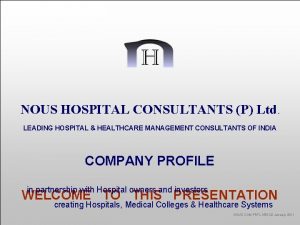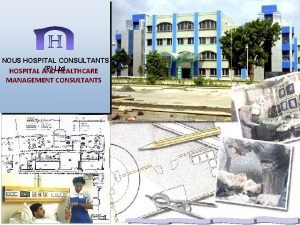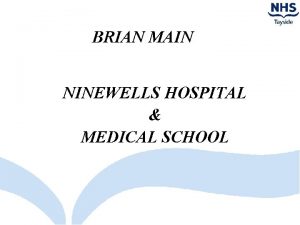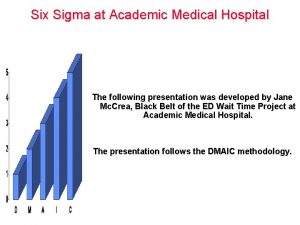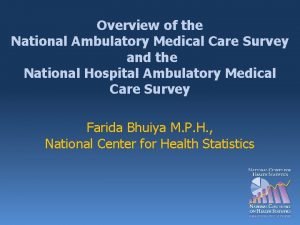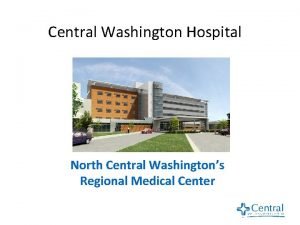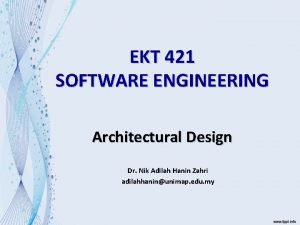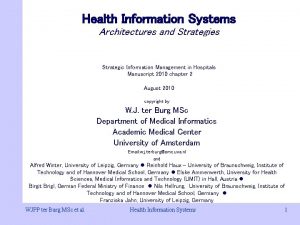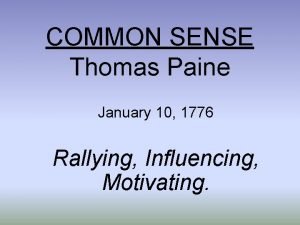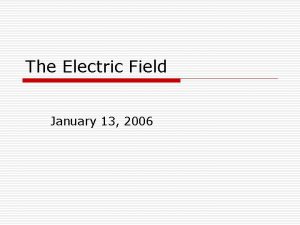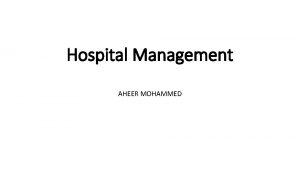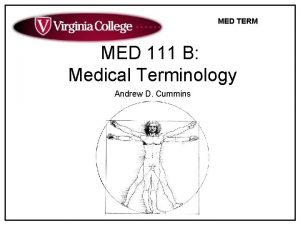MED Architecture January 2014 MEDICAL ARCHITECTURE NOUS HOSPITAL



































































- Slides: 67

MED Architecture January 2014 MEDICAL ARCHITECTURE NOUS HOSPITAL CONSULTANTS (P) Ltd. HOSPITAL AND HEALTHCARE MANAGEMENT CONSULTANTS

MED Architecture January 2014 MEDICAL ARCHITECTURE A PRESENTATION BY DR. K B SOOD NOUS HOSPITAL CONSULTANTS (P) Ltd. LEADING HOSPITAL & HEALTHCARE MANAGEMENT CONSULTANTS OF INDIA in partnership with Hospital owners and investors creating Hospitals, Medical Colleges & Healthcare Systems

MED Architecture January 2014 MEDICAL ARCHITECTURE As ancestral human beings started to organise and as their knowledge became formalised, the human needs increased and they required proper IS and secure shelters in the form of built structures to provide shelter, ARCHITECTURE security, place for meeting, place for worship, etc. WHAT Learning from caves, these early humans made buildings using local materials and gradually became efficient in constructing small buildings. As humans (nomads) settled, materials used became heavier, more solid and more durable providing greater degree of protection and safety in shelters. These buildings had to withstand the vagaries of climate like storm, earthquake, etc. and over centauries of learning, this craft evolved, the designs became standardised and peculiar to Geographical locations. Once the human settlements were stabilised, the social interaction of the society with the built structures, further influenced the design of buildings. As the human civilizations evolved, the cultural practices also impacted design of buildings. In addition to basic shelter, community buildings also came into being. These designs are today called traditional designs and this practice of creating built structures for shelter, community use and other purposes is called “Architecture“.

MED Architecture January 2014 MEDICAL ARCHITECTURE WHAT IS Architects experimented with a variety of natural and modified materials to make buildings, which could withstand vagaries of nature and meet the primary objective of making shelters. ARCHITECTURE We require from buildings two kinds of goodness: first, doing their practical duty well Second that they be graceful and pleasing in doing it. John Ruskin As the human knowledge in scientific fields evolved, more materials, tools and technologies became available for use, the architects began to integrate these in their projects. As the human societies became structured, Architects brought in the aesthetics and individual styles. Later, in the medieval times, buildings which were bigger and ornamental, started to get built to serve as Churches, Town Centres and Castles. This brought in specialisation where the Architects began to concentrate on form, function, aesthetics and the humanist aspects. They associated with engineers to plan, design and provide the needed engineering services for structural strength, landscaping, water works, etc. “Architecture is that great living creative spirit which from generation to generation, from age to age, proceeds, persists, creates, according to the nature of man, and his circumstances, as they change. ” Frank Lloyd Wright

MED Architecture January 2014 MEDICAL ARCHITECTURE The rapid urbanisation of Human society in last few centauries made the practice of Architecture a multi-disciplinary profession with specializations IS in various project types, technological expertises or project delivery ARCHITECTURE methods to create the urban conglomerates. WHAT Inspired by aesthetics of machine, large buildings, which were functional, minimally ornamental and sometimes, high enough to touch the sky were built. These were mostly residential towers, commercial, institutional and public buildings. This came to be known as Modern Architecture. The construction of these became possible as a result of technological developments and clever engineering and availability of materials like glass, steel, iron and concrete. “What looks like wood should also be Today, environmental sustainability has become a mainstream issue and wood and iron the practitioners of Contemporary Architecture also called Green should remain Architecture, place great emphasis on energy efficiency and uses iron. ” Gunter Behnisch sustainable, natural, and recycled materials to create eco-friendly buildings, especially the large public buildings.

MED Architecture January 2014 MEDICAL ARCHITECTURE WHAT IS BUILDING ENGINEERING Linked to practice of Architecture is the practice of Building Engineering deals with application of engineering principles and technology to building design and building construction. To begin with, it dealt with various aspects of water management but now it is intricately linked to application of science, especially physics and mathematics, in solving the problems of society as related to the buildings and the built environment. Today, it is responsible for the design, construction, maintenance and Architects and operation of the buildings and the built environment. Engineers are among the most fortunate of men since they build their own monuments John Prebble It has many sub-specialisations, like Structural Engineering, Materials Science, Electrical Engineering, Mechanical Engineering, Hydrology, Environment, Physics, Chemistry and Biology, etc. Today, a large Building Project, has the Architect as team leader who associates with Structure Engineer, Mechanical Engineer, Electrical Engineer, HVAC Engineer, Public Health Engineer, sometimes with IT Engineer, Lighting, Acoustics and other specialist Engineers.

MED Architecture January 2014 MEDICAL ARCHITECTURE WHY BUILDING REGULATIONS The Building Engineers brought in multi-disciplinary Engineering approach for integration of services, like electricity, water supply, drainage, lifts, etc. This, in turn required that these activities are co-ordinated to provide an acceptable level of protection from fire and other hazards such as earthquakes and provide basic needs such as sanitation. This was the genesis of Building Regulations (controls or codes). Failure of buildings or their structure or services are the primary reason for creation of the Building Regulations The main purpose of Building Codes is to protect public health, safety and general welfare as they relate to the construction and occupancy of buildings and Environmental sustainability. In fact, the Building Regulations have been in existence since the code of Hammurabi (1795 -1750 BC) and there a number of such codes in different civilizations; like the Vastu Shastra in India. While the primary reason for development of Building Codes was fire prevention, it now deals with many aspects of design, construction and use of the built structure.

MED Architecture January 2014 MEDICAL ARCHITECTURE The Building Codes are collection of laws, regulations, ordinances, or other statutory requirements adopted by a Government, Legislative Authority of BUILDING to provide technical guidelines for design, construction, operation, and REGULATIONS maintenance of built structures and to create healthy living conditions in buildings. WHY These are written by experts who specialise in their respective fields. They deal with all aspects of building construction - fire, structure, plumbing, electrical, mechanical, Information Technology, HVAC, etc. Building codes promote safety, productivity and efficiency across all facets Building Code of civil engineering. They establish predictable, consistent minimum enforcement standards for quality and durability of most of the construction materials. always brings more gratitude after disaster strikes than it does before. . . . Codes are reviewed periodically, to integrate technological developments. Building codes are generally the silent protector to the general public and gain importance when a situation occurs where regulations have not been enforced or regulations applied have proved to be inadequate.

MED Architecture January 2014 MEDICAL ARCHITECTURE Still, there are many issues related to workmanship and quality that remain outside the domain of the Building Codes. These are generally considered BUILDING to be consumer in nature, driven by market demands, and vest in the REGULATIONS domain of the local regulators for implementation. WHY Building codes are intended to be applied by Architects, Engineers, Constructors and Regulators but are also used by Safety Inspectors, Environmental Scientists, manufacturers of building products and materials, insurance companies and others. In India, we follow the National Building Code and its derived codes like National Electrical Code and various rules framed therein. The updated Building codes help to improve energy efficiency, keep construction costs down, lower insurance rates and reduce the utility bills. Compliance with Building Codes does not restrict innovation and the new designs, integration of new technologies and new materials leads to upgrading the codes to include these modalities. Finally, one needs to review local building codes vis-à-vis International Codes or codes of other countries, to get an understanding how others are managing similar problems.

MED Architecture January 2014 MEDICAL ARCHITECTURE

MED Architecture January 2014 MEDICAL ARCHITECTURE WHAT IS Medical Architecture deals with Healthcare Spaces, or spaces where Healthcare is delivered. Healthcare delivery involves interaction with dynamics of Life & death situations, therefore all Healthcare buildings are planned & designed to ARCHITECTURE provide support for this process of Healthcare Delivery. MEDICAL The first instruction of Florence Nightingale "The hospital should do patients no harm. " must be obeyed forever while designing a Hospital. Medical Architecture has to meet significant challenges – not necessarily of Building Design and Building Engineering, but the challenges posed by dynamics of Healthcare technologies, delivery practices and policies. The Healthcare technologies are developing at a very fast pace. In fact all technological developments, in any other industry, are constantly being reviewed by Healthcare Industry and it absorbs all suitable developments almost instantaneously. Thus Medical Architecture becomes unique because it creates ever evolving building structures and forms. Quite often, the architect’s brief gets revised during the design or construction stage itself.

MED Architecture January 2014 MEDICAL ARCHITECTURE WHAT IS Impact of Dynamics of Life & Death situations on Healthcare Delivery has to be understood fully by Practitioners of Medical Architecture. MEDICAL Ask any cardiologist and he will tell you that he works with anti-coagulants ARCHITECTURE day in and day out but occasionally, there is a patient who is allergic to them and dies suddenly during a procedure. Hospital building design must cater for this occasional mishap and try and save this life. What is required is an integrated Coronary Care Unit with the Cardiac Cath Lab to facilitate quick transfer of the patient so that IABP (a device to support heart function) can be put in to prevent immediate death and A proper patient can be re-assessed. design Design Intent: Seamless Integration of Rooms with adequate door actually contributes to openings, controlled environment and traffic. the Healing Here the design plays a very important role as this patient must be cared Process and for physically 24 x 7; must be visited by his doctor, therapists and relatives; aids the must be saved from noise, infection and malnutrition; and yet the costs Healthcare have to be controlled and the main cause must be treated. Delivery

MED Architecture January 2014 MEDICAL ARCHITECTURE WHAT IS Medical Architecture has, over the years, contributed to development of various principals of the Universal Design as practiced in General Architecture. MEDICAL ARCHITECTURE Universal Design evaluates the use of buildings and spaces by people of Medical Architecture must evaluate both the Industrial Engineering principles and Healthcare Delivery processes and make judicious integration. all kind, including able bodied and disabled, whether temporarily or permanently, and provides design based solutions so that all persons are able to use and interact with spaces created in a universal but least interfering manner, and derive maximum functional utility – best as per their physical ability. Medical Architecture has imbibed the high points of easy access; helped to reduce accidents taking place within built form due to limitation of mobility or sight or hearing or comprehension of levels, etc. ; established easy way finding by using graphics, symbols and fittings; created easy traffic of all – personal, service providers, goods and stores; and made provision of utilities for all age groups either as a universal design or by clustering together different utilities for different groups of persons- by age, by genders or by physical abilities.

MED Architecture January 2014 MEDICAL ARCHITECTURE WHAT IS MEDICAL ARCHITECTURE IMPORTANT NOTE Healthcare Facilities are designed for use by more than one group of End Users Spaces in Healthcare Facilities should be comforting and provide order to increasingly complex and chaotic schedules of Healthcare Delivery Process. Practitioners of Medical Architecture have to understand, that the Healthcare Facilities are used not only by the patients, but also by all kinds of people that interact with the physical and the organisational facilities starting from the community, to the casual visitor, the nurse, the clinician etc. ‑ and that the design decision have to incorporate a wide variety of parameters to suit them all. It has to include urban design, building design, space-unit design, interior design, and equipment design parameters. It also has to evaluate external environment, finishes and landscaping parameters. In addition, it has to insure that the built facility is easy to clean, maintain and consumes least amount of expensive energy resources. It must provide islands for staff where they have stress bursting facilities.

MED Architecture January 2014 MEDICAL ARCHITECTURE WHAT IS MEDICAL Medical Architecture needs to understand provide the following capabilities to the built structure, form and space. Ø Ability to assist the healing component of Healthcare delivery Process by providing fully controlled environment Ø Ability to integrate new processes and technologies on a continuous basis Ø Ability to provide adequate engineering service support to all new processes and technologies ARCHITECTURE It is a well known fact that Medical Architecture directly impacts Quality of Healthcare delivered Practice of Medical Architecture requires a basic knowledge of Healthcare Delivery Process; knowledge of major Medical Equipment across all Medical Specialities; understanding of the Infection Control Process; ability to integrate the stated workflow with the built form; create areas, spaces and services which conform to various accreditation standards. All Healthcare spaces, in general are public spaces. Within each space, there are non-public areas but overall, Healthcare spaces are categorised as Public Spaces.

MED Architecture January 2014 MEDICAL ARCHITECTURE WHAT Medical Architecture deals with following building types. IS Ø Hospitals & Nursing Homes of various types MEDICAL Ø Dispensaries, Polyclinics and smaller Clinics ARCHITECTURE Ø Diagnostic Centres Ø Medical, Dental, Nursing Colleges & other teaching, training Institutes Ø Health Sanatorium & Health Club It is said that if not well planned, the Hospital building becomes ancient by the time it gets built Of these Hospital is the most visible face of Healthcare Industry. Hospitals represent nearly 80% of all Healthcare Spaces so Medical Architecture has come to symbolise Hospital Architecture. In fact, all elements of Healthcare Delivery, as present in a typical medium to large hospital facility, are generally represented in all other types of Healthcare delivery facilities. Building a Hospital is considered one of the most complex problems in Planning, Designing and Construction.

MED Architecture January 2014 MEDICAL ARCHITECTURE HOSPITALS ARE THE MOST COMPLEX HUMAN ORGANISATION EVER DEVISED Peter Drucker

MED Architecture January 2014 MEDICAL ARCHITECTURE TODAY HOSPITAL BUILDINGS ARE THE MOST COMPLEX BUILDING TYPES v v v v INTEGRATION OF DEVELOPING TECHNOLOGIES INTO HEALTHCARE DELIVERY IS MAKING HOSPITALS MORE COMPLEX

MED Architecture January 2014 MEDICAL ARCHITECTURE PLANNING THE HOSPITAL Creation of Hospital is a multi disciplinary job, involving various specialists like Hospital Consultants, Architects and Engineers, who design and construct the buildings, create the various systems of handling man, material and information and generate the atmosphere where Healthcare is delivered by first intention and by interaction of Healthcare providers with the patient and his visitors. Hospital is not just a building, but a complex social institution, composed of many subgroups, representing a wide variety of interests and diverse needs. Building a Hospital is considered one of the most complex problems in Planning, Designing and Construction It utilises the services of various Medical, Paramedical and Support personnel to render all Healthcare needs to the patients in its custody. It is here that the Healthcare Technology gets integrated with the living process. There is a fusion of a wide spectrum of organisational skills, professional expertise and diverse interests. Hospitals are deemed to be essential services. They are required to and must perform in times of disasters and emergency.

MED Architecture January 2014 MEDICAL ARCHITECTURE PLANNING THE HOSPITAL Since, delivery of Healthcare involves all segments of community either as Healthcare provider or the Healthcare recipient, the Hospital must imbibe and reflect various cultural practices of the community in its primary catchment area. The aesthetics of Hospital patient rooms and spaces is a statement of the current cultural practices of the community. The planning of Hospitals is structured to realise this integration of Technology; Cultural practices with immediate and long-term objectives of the Healthcare Plan, which it has to serve. Additionally, Hospitals are over designed in comparison to all other public buildings to provide them extra safety. In Hospital Building Projects, Hospitals need a coherent, organised structure to overcome its complexity, where each one has adequate freedom to practise his skill, and at the same time, compliment the work of others leading to effective Healthcare. it is the Function, The Architects have to design and build around this structure to create which dictates various kinds of clean and protected environment for the Healthcare the Form providers to practice their skills.

MED Architecture January 2014 MEDICAL ARCHITECTURE PLANNING THE HOSPITAL While planning a Hospital Project, whether in a new building or by upgrading an existing building, a Healthcare Plan must be available. If a Healthcare Plan is not available, it must be generated. The Healthcare Plan leads to activity analysis and functional analysis. Typically, first activity analysis of delivery of Healthcare and then a detailed analysis of Hospital operations is carried out to generate the functional planning parameters for any hospital. The Functional Master Plan is then established to convert the Healthcare Plan requirements into a Functional Plan - one that best meets the objectives identified. Functional Plan must also provide basic Hospital operation activities Where, Healthcare Plan can be grandiose, the Functional Plan has to be within the Hospital’s limits of financial capability. The Functional Plan proposes to deploy the available capital in the most effective manner, to realise the stated objectives.

MED Architecture January 2014 MEDICAL ARCHITECTURE PLANNING THE The Functional Plan also determines the appropriate technologies that will be deployed, to create the physical facility and the operating environment in this facility. HOSPITAL It also determines the level of sophistication of the Healthcare delivery process. It must list all clinical support services required, like Surgical Suite, Blood Bank, Imaging Suite, Clinical Laboratory, etc. and all central services like CSSD, Laundry, Catering Services, etc. Functional brief is the final definition of the aims and objectives of the Healthcare plan Functional Plan also states Hospital’s requirements for various Engineering services, to provide it with Energy, Water, Steam, Piped Medical Gases, Communications, etc. It quantifies the workload in measurable units, like No. of beds, patients, consultant's visits, procedures, personnel in various specialities, anticipated utilisation factors, level of sophistication of facilities and equipment and detailed description of spaces and the relationship between the spaces.

MED Architecture January 2014 MEDICAL ARCHITECTURE PLANNING The Functional Plan details all its requirements in terms of, THE Ø Physical facility which comprise of various Buildings and Building Blocks, Engineering Services, Hospital Utility Services and Support Services HOSPITAL ü It must specifically list all such areas where the environment needs to be controlled to create Clean rooms or rooms with special environment Ø Departmentation Plan delineating various activities into comprehensive groups Functional brief is prepared by the Hospital Consultant in association with the Architect Ø Inter Departmental Relationships to establish their location, and proximity to other areas and services Ø Equipment Plan providing list of all needed Medical and Allied Equipment and details for all equipment that has installation requirements

MED Architecture January 2014 MEDICAL ARCHITECTURE PLANNING The Functional Plan details all its requirements in terms of, THE Ø Manpower Plan providing for Medical Staff, Technical & Nursing Staff, Administrative and Support Staff and a statement on the population densities in all areas. HOSPITAL Ø Hospital Supply Systems providing for all needed Medical & Surgical supplies, Sterile Supplies and other needed supplies for Housekeeping, Catering and maintenance. Functional brief must embrace information on all aspects of the functions which are relevant to the design Ø Hospital Administrative Structure and Basic Hospital Administration Plan Ø Hospital Medical Administrative Structure and Plan as related to the Hospital’s Revenue budget. Ø Phasing Plan where creation of all above listed facilities, services, etc. are linked to a time frame.

MED Architecture January 2014 MEDICAL ARCHITECTURE ARCHITECT’S BRIEF The next step is to develop the Architect’s Brief. In addition to the functional plan, it describes all design parameters. It also describes all functional and accreditation requirements. WHY are the functions being performed? HOW are they performed? BY WHOM shall they be performed? AND it helps to create the Architectural WHERE these functions shall be performed Brief is a statement of client's Architect’s Brief establishes the "Bricks and Mortar" resources needed to requirements, which forms implement the Hospital’s Functional plan. the basis for Design of the Hospital

MED Architecture January 2014 MEDICAL ARCHITECTURE ARCHITECT’S BRIEF The Flow Diagram of activity has to be detailed to include all activities Architect’s Brief provides a detailed statement of all activities that shall be performed and list of areas that have to be created in a Hospital, organised into department and other sub-units, which can be comprehended by the design team.

MED Architecture January 2014 MEDICAL ARCHITECTURE ARCHITECT’S BRIEF Having determined the various services to be provided, a detailed room wise list has to be generated where each activity shall be carried out in a logical manner. This room wise list must also provide the minimal functional area that needs to be created. The Functional Analysis statement states the minimal carpet area requirement and provides a detailed list of various rooms etc. , and the required numbers. One must also specify all special dimensions that may be required in any room. This Functional area is generally described and grouped into subunits as per the Functional Plan (Departmentation plan) It is presented as Ø Functional Areas, Ø Support Areas Ø Service Areas

MED Architecture January 2014 MEDICAL ARCHITECTURE ARCHITECT’S BRIEF The minimal functional area must have catered for intramural circulation, which means it must cater for equipment layout as required and for circulation within the room. Functional Areas represents the areas where the primary functions of the respective sub-unit are performed. e. g. the in patient unit or the nursing station in a Nursing Unit; Operating Room in a Surgical Suite. As far as possible, the size of these areas shall not be changed. Relations of all other areas shall be established in relation to the properties of these areas. Support Areas represents the areas where such functions are performed which directly support or enable the performance of primary functions of the respective sub-unit. e. g. the clean utility room in a Nursing Unit; Nursing Station in a Surgical Suite. The size of these areas can be changed to accommodate design constraints but the integrity of their relation to functional areas shall be maintained. Support areas of two or more similar functional units, located in proximity of each other, can be grouped and shared by each functional unit. Service Areas represents the areas where such functions are performed which do not directly support the performance of primary functions of the respective sub-unit. e. g. the Sluice Room in a Nursing Unit; Radiology Dark Room in a Surgical Suite. The size of these areas and their relation to functional areas can be changed to accommodate design constraints.

MED Architecture January 2014 MEDICAL ARCHITECTURE EXAMPLE OF THE AREA STATEMENT

MED Architecture January 2014 MEDICAL ARCHITECTURE ARCHITECT’S BRIEF Architect’s Brief provides design parameters in sufficient detail for the Building Engineers to conceive, plan and design the required services. These include some or all of the following. The Brief should provide clearly the requirement of Building Management System. 1 Acoustics Requirements 2 Air Handling and HVAC Requirements 3 Closed Circuit TV Systems 4 Communication Systems like Telephones, Wireless Communication and Paging Systems 5 Computer Requirements 6 Disaster Management Alarm Systems 7 Electric Power Receiving and Distribution Systems including provisioning of Equi-potential Conductor Systems, Generators, etc. 8 Fire Detection Systems 9 Fire Fighting Systems

MED Architecture January 2014 MEDICAL ARCHITECTURE ARCHITECT’S BRIEF Architect’s Brief provides design parameters in sufficient detail for the Building Engineers to conceive, plan and design the required services. These include some or all of the following. The Brief should provide reference to standards or provide copies of standards that have to be complied with for deployment of services 10 General Indoor Lighting and Fannage Systems including Illumination levels 11 Hazard Management Systems 12 Hot Water Systems including provision for Hot Water Boilers and Steam Boilers 13 Housekeeping Systems 14 Internal Plumbing Systems 15 Lightening Protection Conductor Systems 16 Outdoor Lighting Systems including the perimeter Lighting, Street Lighting and Building Illumination 17 Piped Medical Gases Systems 18 Piped Music Systems

MED Architecture January 2014 MEDICAL ARCHITECTURE ARCHITECT’S BRIEF Architect’s Brief provides design parameters in sufficient detail for the Building Engineers to conceive, plan and design the required services. These include some or all of the following. The Brief should clearly lay down the standards that must be complied with for privisioning of these services, especially for accreditation 19 Public Announcement Systems 20 Sewerage Systems including collection and conveyance of Sewage and Waste Water, Effluent Treatment System 21 Storm Water Drainage Systems including provision of Grease traps for Kitchen, provision of Delay and decay tanks for Radioactive Waste water, provision of Delay and treatment tanks for Biomedical and toxic Waste water 22 Traffic Systems specifying the width of access to various functional areas. 23 Video Cable Systems 24 Water Supply Systems including Water Source Development, Water Treatment, Water storage and Distribution Systems 25 Waste Management Systems including special provisions for Bio‑medical and Hazardous solid and liquid Waste

MED Architecture January 2014 MEDICAL ARCHITECTURE ARCHITECT’S BRIEF Architect’s Brief will include the Traffic Analysis to determine the No. of Cores to be provided, size of exits, size of Hospital Street and other related areas for internal traffic and external traffic. It also determines peak population, cart traffic and assists in planning the distribution of services. If there any special requirements for installation of Equipment in terms of wall thickness or point load factors, these must be clearly brought out It will also provide requirement of Ramps, Lifts and Escalators, as appropriate. Then it must provide a list of all Equipment – building utility Equipment, Medical equipment, equipment as required for support services and plant and machinery required for service functions. . It is generally categorised into two (2) major categories as under for administrative convenience. Ø Building Utility Services Equipment Ø Hospital Equipment

MED Architecture January 2014 MEDICAL ARCHITECTURE ARCHITECT’S BRIEF Architect’s Brief will establish the Atmosphere to be created for delivery of Healthcare. It must describe the accreditation requirements, statutory compliance requirements for the built facility and the Patient Comforts to be provided. It must provide Rough Design Calculations. If applicable, it should detail the Phasing Plan so that a Master Plan and a Phasing plan can be created by the designing team. The phasing plan must cater for future expansion in a manner where existing hospital activity is not disturbed Phasing must be done in a manner that the resultant building and departments must be able to deliver comprehensive healthcare, even to a lower level of specialisation than planned but by itself, it should be complete and meet the criteria for comprehensiveness as practiced in teaching Hospitals or other similar hospitals. Phasing plan is a vital component of projects being renovated. Unless the existing facility is closed completely or demolished, Continuity of Care has to be provided in Hospitals.

MED Architecture January 2014 MEDICAL ARCHITECTURE ARCHITECT’S BRIEF Architect’s Brief shall never provide A building design nor will it relate the function delivery to a specific design In summary, The Architect can now develop the most appropriate design for the given site, which meets the various statutory requirements, which provides cost effective Healthcare and which is aesthetically pleasing. The Architect’s Brief shall elucidate the operative principles of patient care to enable the designing team to understand design a building which shall emphasis the spirit of the Healthcare Plan. It shall specify the general tone of various areas viz. the patient waiting areas, administrative areas, staff lounge etc. and the basic AURA, that the building should possess. It must provide a statement of all areas that have to be created in a Hospital, organised into department and other sub-units, which can be comprehended by the design team. Lastly, it describes the concept of integration of various engineering principles with delivery of Healthcare leading to creation of areas where Healthcare can be delivered in a safe & comfortable manner.

MED Architecture January 2014 MEDICAL ARCHITECTURE “Even minor deficiencies in Building Design may reduce efficiency, increase cost of maintenance or require more employees, and may mean the difference between the Hospital rendering good Patient Care and one which fails in its community responsibilities. ” Dr. J. R. Mc. Gibnoy

MED Architecture January 2014 MEDICAL ARCHITECTURE BASIC PRINCIPLE OF PLANNING HOSPITALS FUNCTIONAL ANALYSIS PLAN FROM INSIDE TO OUTSIDE

MED Architecture January 2014 MEDICAL ARCHITECTURE BASIC PRINCIPLE OF Ø First define the activities, functional, support and service activities Ø Put them in proper relationship with one another in both – Horizontal & PLANNING Vertical axis HOSPITALS Ø Develop an envelope called Hospital Building to encase this The more detailed is the definition of activities and their relationships the better is the Hospital Building ALWAYS PLAN FROM INSIDE Add as many parameters as you like Equipment Systems, Security Systems, Access Control Systems Control Of Nosocomial Infections, Store & Supply Systems Maintenance Systems, Principles Of Green Building Energy Conservation Systems, Etc. TO OUTSIDE THE SECRET OF GOOD HOSPITAL BUILDING DESIGN LIES IN DETAILED FUNCTIONAL ANALYSIS

MED Architecture January 2014 MEDICAL ARCHITECTURE IT IS A MUTUAL RESPONSIBILITY CREDIBLE EVIDENCE INDICATES DESIGN CAN IMPROVE CLINICAL OUTCOMES AND PATIENT SAFETY THEREFORE MEDICAL ARCHITECTS HAVE A MORAL RESPONSIBILITY TO UTILIZE SUCH EVIDENCE AND HOSPITAL PLANNING CONSULTANTS MUST MAKE IT POSSIBLE

COMPLETED IN THE YEAR 1917 MED Architecture January 2014 MEDICAL ARCHITECTURE EVOLUTION OF HOSPITAL DESIGN

MED Architecture January 2014 COMPLETED IN THE YEAR 2005 MEDICAL ARCHITECTURE

MED Architecture January 2014 MEDICAL ARCHITECTURE EVOLUTION If one looks at the huge variety of building forms adopted by Modern Hospitals, one might not find a logical evolution over the past one or two OF centuries. The 19 th century saw the revolution in Hospital Design for the following reasons HOSPITAL DESIGN 1816: Stethoscope is invented 1818: first successful human blood transfusion is performed 1842 : Anaesthesia with ether established pain control Evolution of Hospital design is closely linked to evolution of Healthcare Delivery 1861: Lister provided antisepsis 1863: Nightingale’s wrote “Notes on Hospitals” first brief for Medical Architecture 1865: Surgery moved from a ward side-room or the kitchen table to a dedicated, operating room First group of trained Nightingale Nurses Started Work 1879: First vaccine for cholera used 1892 : First X-ray department came into being 1903 : Willem Einthoven discovers electrocardiography

MED Architecture January 2014 MEDICAL ARCHITECTURE EVOLUTION Apart from logistic & nursing departments separate area was added for diagnostic services for which the patient had to become mobile OF The traffic of patients on trolleys or beds became a design issue HOSPITAL DESIGN By the turn of the 19 th century, new building technology addressed the issue of land-use. Steel and concrete together with elevators and mechanical ventilation made the vertical stacking of Departments possible. Most of old Hospitals were built in Temple Courtyards because the Priests were also working as healthcare Providers In fast growing cities, with scarce expensive land plots, vertical construction was implemented. In 1912, Dr. Goldwater suggested a modified Nightingale Ward for vertical Hospitals, which was adopted in most developed countries. This resulted in construction of a large number of Hospitals in tall, tower-like structures. This structure was modified from a central traffic corridor to double - loaded corridor plans.

MED Architecture January 2014 MEDICAL ARCHITECTURE EVOLUTION OF HOSPITAL DESIGN A 'Nightingale ward' at St Thomas's Hospital ca. 1910 -17

MED Architecture January 2014 MEDICAL ARCHITECTURE EARLY OPERATION THEATRE

MED Architecture January 2014 MEDICAL ARCHITECTURE EVOLUTION As the new developments in Healthcare were integrated in hospitals and new departments added to Hospital organisational structure, the Healthcare OF delivery became a complex process carried out in a number of rooms located in different parts of the building. HOSPITAL DESIGN The complexity of the internal traffic of Hospital could no longer cope with the limited possibilities of vertical elevator traffic. In response, European hospital planners developed two strong alternatives in high-rise Hospital design. 1. The tower - on - a - podium 2. The tower - with - technical block

MED Architecture January 2014 MEDICAL ARCHITECTURE EVOLUTION OF HOSPITAL DESIGN These Designs looked for Departmental Co-ordination Wards on upper floors All Procedure Rooms Diagnostic Rooms on Lower Floors THE TOWER - ON - A – PODIUM STRUCTURE

MED Architecture January 2014 MEDICAL ARCHITECTURE TOWER ON A PODIUM

MED Architecture January 2014 MEDICAL ARCHITECTURE EVOLUTION OF HOSPITAL DESIGN These Designs looked for Optimisation of Departmental Locations TOWER - WITH TECHNICAL BLOCK STRUCTURE

MED Architecture January 2014 MEDICAL ARCHITECTURE THE TOWER - WITH - TECHNICAL BLOCK

MED Architecture January 2014 MEDICAL ARCHITECTURE EVOLUTION During and after World War II, the explosion of medical specialities and thus medical departments tested the concept of a vertically organised OF Hospital and found its performance dismal. HOSPITAL In response, horizontal pattern Hospitals were designed and built. DESIGN Then the main turn came in 1957 by the proposal of Isadore Rosenfield for the new medical premises at Stanford University, Palo Alto, where he could convince the faculty that it is better "to go out than up". His design, a large medical low-rise core building with nursing units plugged in either side, was a new direction in the field. The Built environment brought its problems in the form of Hospital acquired Infections In the sixties, John Weeks the British private architects, and William Tatton Brown Governmental architects have contributed to the development of the compact "Low-rise hospital".

MED Architecture January 2014 MEDICAL ARCHITECTURE ADVANCED PAEDIATRIC CENTRE POST GRADUATE INSTITUTE OF MEDICAL EDUCATION AND RESEARCH large medical lowrise core building with nursing units plugged on either side

MED Architecture January 2014 MEDICAL ARCHITECTURE EVOLUTION Then, inspired by high tech Building Technology, the Hospital Environments evolved into very sophisticated environments. (Illustrated by Mc Mater, OF Toronto, Canada, and the University Hospital at Aachen, Germany) HOSPITAL DESIGN These hospitals were expensive to build and operate. They consumed extremely high and costly energy. In operation, they provided dangerous environments where noso-comial diseases, sick-building syndrome and allied iatrogenic disease were born. Apart from the dendritic or grid-type horizontal hospital traffic-patterns, allowing a nearby clustering of highly interdependent hospital departments, a further morphological breakthrough was introduced by the Leuven concept of nursing-floors, a lay-out integration of 4 or more nursing units on one floor, allowing a better management of nursing costs. This took various forms in different hospitals from Y shape to C Shape.

MED Architecture January 2014 MEDICAL ARCHITECTURE EVOLUTION OF HOSPITAL DESIGN These Designs looked for natural light and ventilation Y SHAPED GRID PATTERN G B PANT HOSPITAL NEW DELHI

MED Architecture January 2014 MEDICAL ARCHITECTURE C SHAPE GRID PATTERN Klang, Malaysia - Pantai Klang Hospital 150 Bedded General Hospital

MED Architecture January 2014 MEDICAL ARCHITECTURE Armed Forces Hospital Mustafa Kamel, Alexandria - Egypt

MED Architecture January 2014 MEDICAL ARCHITECTURE EVOLUTION In the later part of twentieth century, new construction material and technology influenced Hospital Building design and one can see all OF types of Hospital Buildings. HOSPITAL DESIGN The main influence was availability of steel structures, which enabled creation of really large, spacious structures enclosing large atriums. These hospitals were serviced by elevators and automated distribution services for kitchen, stores and other goods. Enclosed The exteriors and interiors were treated with glass and gradually spaces in progressed to be column less large areas with controlled environment. Hospital required artificial light and Ventilation This later progressed into smart building forms by deploying Building and became Management systems, which provided automated control over nearly Energy all engineering services deployed in the Hospital. Guzzlers

MED Architecture January 2014 MEDICAL ARCHITECTURE S. A. Niyasov International - Medical Centre Ashgabat – Turkmenistan

MED Architecture January 2014 MEDICAL ARCHITECTURE HENRY DUNANT HOSPITAL RED CROSS ATHENS, GREECE 452 BEDS

MED Architecture January 2014 MEDICAL ARCHITECTURE G K GENERAL HOSPITAL, BHUJ, GUJARAT - 300 Beds

MED Architecture January 2014 MEDICAL ARCHITECTURE MEDICAL INSTITUTE OF ORTHOPAEDICS & TRAUMA, CHENNAI

MED Architecture January 2014 MEDICAL ARCHITECTURE PRE-FABRICATED INSULATED BUILDING

MED Architecture January 2014 MEDICAL ARCHITECTURE EVOLUTION OF HOSPITAL Some Hospitals are so huge that they represent an urban complex by itself, spread over large areas with their housing and service blocks, they have most of the components of an urban estate like schools, markets, Inns, etc. DESIGN The CMC Vellore or the Medical College complex in Pondicherry are such examples. Today, the emphasis is on creating a more energy efficient Hospital design, with least ecological impact Most of the large Hospitals in the world are actually Medical Universities with multiple Healthcare Centres, multi institution teaching facilities, research centres and large residential complexes. Escuela Latinoamericana de Medicina (ELAM), formerly Latin American School of Medical Sciences, in Cuba is the largest International Medical School. Established in 1999 and operated by the Cuban Government, ELAM has, 10, 000 or 12, 000 medical students from 49 countries reported enrolled, in 2006 - 2007.

MED Architecture January 2014 MEDICAL ARCHITECTURE DAKOTA HOSPITAL, FARGO (1965)

MED Architecture January 2014 MEDICAL ARCHITECTURE EVOLUTION OF HOSPITAL A state-of-art hospital is a complex grouping of departments, equipment, patients, and staff. DESIGN The factors that influence Human Health and performance fit hand in hand with the Architectural Parameters that enable buildings to work within the natural environment All these must operate seamlessly to be an effective enterprise v v v END OF PART – I – MEDICAL ARCHITECTURE

MED Architecture January 2014 MEDICAL ARCHITECTURE NOUS HOSPITAL CONSULTANTS (P) Ltd. LEADING HOSPITAL & HEALTHCARE MANAGEMENT CONSULTANTS OF INDIA OFFICE : WEB SITE E MAIL TELEPHONE : : : 31 CSC GULMOHAR PARK, NEW DELHI - 110 049 www. nousdoc. com nousdoc@vsnl. com (+ 011) 2685 8017 REGD. OFFICE : C-145, NIRMAN VIHAR, NEW DELHI - 110 092

MED Architecture January 2014 MEDICAL ARCHITECTURE NOUS HOSPITAL CONSULTANTS (P) Ltd. LEADING HOSPITAL & HEALTHCARE MANAGEMENT CONSULTANTS OF INDIA
 Nous t'adorons o christ et nous te benissons
Nous t'adorons o christ et nous te benissons Seigneur nous croyons en toi fais grandir en nous la foi
Seigneur nous croyons en toi fais grandir en nous la foi Nous allons nous revoir
Nous allons nous revoir Nous sommes chez nous
Nous sommes chez nous Kuranda tedvir ne demek
Kuranda tedvir ne demek Nous hospital consultant
Nous hospital consultant Nous hospital consultant
Nous hospital consultant Organization structure of hospital pharmacy
Organization structure of hospital pharmacy Tung shin tcm
Tung shin tcm Kaohsiung medical university hospital
Kaohsiung medical university hospital Ninewells hospital and medical school
Ninewells hospital and medical school Six sigma at academic medical hospital case analysis
Six sigma at academic medical hospital case analysis National hospital ambulatory medical care survey
National hospital ambulatory medical care survey Torrance memorial medical records
Torrance memorial medical records Doctors in north central washington
Doctors in north central washington Doctors license number
Doctors license number Gbmc infoweb
Gbmc infoweb Difference between medical report and medical certificate
Difference between medical report and medical certificate Cartersville medical center medical records
Cartersville medical center medical records System architecture diagram for hospital management system
System architecture diagram for hospital management system Healthcare information system architecture
Healthcare information system architecture January 27 1756
January 27 1756 Zodiac for january 20
Zodiac for january 20 Birth newton
Birth newton February and march season
February and march season January february march
January february march January 2016 chemistry regents answers
January 2016 chemistry regents answers January 2012 chemistry regents
January 2012 chemistry regents June 2012 chemistry regents answers
June 2012 chemistry regents answers January starts the year poem risa jordan
January starts the year poem risa jordan Ib physics hl grade boundaries
Ib physics hl grade boundaries Character trait respect
Character trait respect Paula hurlock birthday
Paula hurlock birthday January 27 1756
January 27 1756 In which year was mozart born
In which year was mozart born January february spelling
January february spelling What is the theme for the month of january
What is the theme for the month of january Beetlejuice planet size
Beetlejuice planet size January 24, 1848
January 24, 1848 Meridel lesueur, new masses, january 1932
Meridel lesueur, new masses, january 1932 Polytechnic hardware store
Polytechnic hardware store 25 january 1759
25 january 1759 An asset was purchased for $120 000 on january 1
An asset was purchased for $120 000 on january 1 Letter to senator robert wagner 1934
Letter to senator robert wagner 1934 1st january 2018
1st january 2018 How many syllables in discovery
How many syllables in discovery Lipsume
Lipsume Blackberry devices working on january
Blackberry devices working on january Jill kally
Jill kally January 19 1809
January 19 1809 When was edgar allan poe born
When was edgar allan poe born January 10th 1776
January 10th 1776 Spatial january
Spatial january How old are you peter weatherall
How old are you peter weatherall Your impolite tone surprises me passive voice
Your impolite tone surprises me passive voice December november october
December november october January 31 2006
January 31 2006 April may june july
April may june july Pro-forma entry
Pro-forma entry January 2012
January 2012 Mozart was born in salzburg ... 1756
Mozart was born in salzburg ... 1756 January 13 2006 calendar
January 13 2006 calendar Arvod cannot find work as a mall santa in january.
Arvod cannot find work as a mall santa in january. 15 janvier 1929
15 janvier 1929 King naci
King naci January 29 2015
January 29 2015 Sunday, tuesday, january, saturday
Sunday, tuesday, january, saturday January 15, 1929
January 15, 1929





